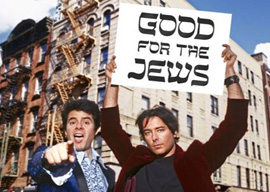
December 12, 2012

Jewish cultural power was formidable long before the 1960s, but it was rather reticent and defensive. The 60s represented a transition period. Before 1967, Jews had typically asked their classic question “Is It Good for the Jews?“ about their own conduct.
Sandy Koufax’s pitching? Good for the Jews.
Julius and Ethel Rosenberg’s atom-bomb espionage? Not good for the Jews.
As inheritors of the German musical tradition, Jews had dominated American popular songwriting for decades with their craftsmanship. But in a 1960s obsessed with authenticity, Tin Pan Alley and Broadway were old hat. New York professionals such as Carole King had to regroup and re-launch themselves in the 1970s as mellow California singer-songwriters.
A leading figure in this tidal shift away from professionalism was Bob Dylan. But coming from Duluth (of all places) with his obsession with folk (i.e., goy) songs and the “old, weird America,” he was easier for Jews to praise than to imitate. When Dylan published an autobiography a few years ago that didn”t devote much space to his ethnicity, it started to sink in that Dylan may have been almost as much of an American assimilationist as Louis B. Mayer.
Likewise, the rise of Black Power in the 1960s was, on the whole, not good for the Jews. Rich Jews had long quietly funded black civil-rights organizations. This had been a mutually beneficial relationship: Making racial discrimination against blacks unfashionable made ethnic discrimination against Jews increasingly unthinkable. In his essay “Radical Chic,” Tom Wolfe quotes the Jewish social scientist Seymour Martin Lipset:
The integrationist movement was largely an alliance between Negroes and Jews (who, to a considerable extent, actually dominated it).
But the sudden triumph of civil rights in the mid-1960s and the rapid onset of black pride had unexpected consequences. Lipset continued:
The Black Nationalist leadership had to push whites (Jews) “out of the way,” and to stop white (Jewish) “interference” in order to get whites (Jews) “off their backs.”
Thus, composer Leonard Bernstein was baffled to find that many of his fellow Jews objected vehemently to him holding a fundraising party for the Black Panthers. Many less august Jews, it turned out, were shopkeepers and schoolteachers in black neighborhoods. In the late 1960s, much of this struggle was fought out symbolically over Israel. As Wolfe noted:
But many Jewish leaders regarded the anti-Zionist stances of groups like the Panthers as a veiled American-brand anti-Semitism, tied up with such less theoretical matters as extortion, robbery and mayhem by blacks against Jews in ghetto areas.
Over time, Jewish Americans discovered a workable solution to this problem: Stop being shopkeepers and schoolteachers in black neighborhoods. There are better jobs out there. For example, Jewish liquor-store owners in Watts typically sold their stores to black businessmen after the 1965 riot.
A more general discovery was the wide usefulness of Israel’s strategy in 1967: Go on the offensive. This military triumph infused American Jews with new confidence. Before the Six-Day War, the Holocaust was only occasionally mentioned. It was depressing and alarming to admit that your people had recently been the victims of the worst massacre ever. But after Israel’s show of force, the Holocaust became a staple in American media.
After the 1960s, Jews stopped asking the question, “Is it good for the Jews?” about their own behavior and started asking it about everyone else’s.